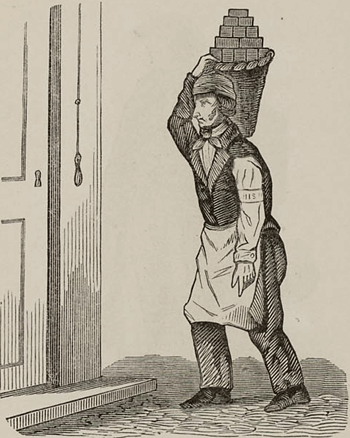A turfdrager was a peat carrier. Peat was an important fuel, both for private homes and for businesses like breweries and bakeries.

Peat carrier. Credits: J. Schenkman, Prentenboek (1850); Digitale Bibliotheek voor de Nederlandse Letteren.
An abstract of the instructions for the peat carriers in Leeuwarden from 1660 gives an impression of the regulations that a peat carrier was expected to live by.
Articles that regulate the peat carriers of this city
- Nobody will be admitted as peat carrier without the consent and approbation of the magistrate of the city.
- Peat carriers are required to carry and bring the peat to those locations, including attics, sheds, and otherwise, that the buyers indicate.
- The peat carriers will maintain the baskets used to carry the peat at their expense, which shall be marked with the city coat of arms.
- The peat carriers shall be required to allot the peat as soon as somebody purchases some peat, in the presence of the overseer.
- That the peat carriers, once they start a task, will be required along the peat measurers, regardless whether there are one, two, three or more barges of peat, to carry the peat from them and to labor until the work is finished and not be allowed to quit or do other work.
- That each peat carrier for carrying light peat to bakers, brewers, soap makers, painters, malt makers, and other persons who use light peat for their trade, shall receive for each barge six “stuivers” [5 cent pieces] or proportionally less.
- And from “baggelaer” and other heavy peat to be stored at the citizens and residents for each barge 10 stuivers or proportionally less.
- That the peat carriers in carrying in the peat shall satisfy themselves with such drink beer as the buyer of the peat finds fit to provide, and that nobody is required to pour “wip” or other beer, and that they cannot be provided money, wine, or beer, by the barge operators.
- That the peat carriers while carrying peat will not be allowed to drink or use any tobacco, outside nor inside the house, to prevent accidents.
- That carrying peat as mentioned above also includes the peat at the Vliet and outside this city if it is stored inside the city, if the council permitted it.
Court (Leeuwarden), Klein Instructiebook [small instruction book], 1660-1751, fol. 6-8v, instruction for peat carriers (16 July 1660); browsable images, AlleFriezen (http://www.allefriezen.nl : accessed 30 November 2017), query voornaam: Nedergerecht Leeuwarden.


An intersting book of rules in Friesland.
I have an ancestor who was a ‘turftonster’ in Schiedam.
Looks to me also a very backbending job.
Hettie in BC